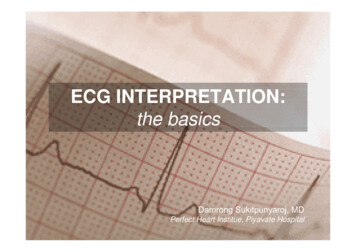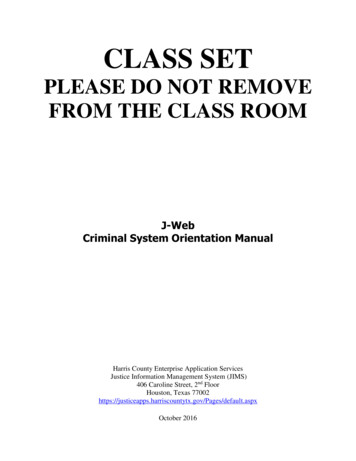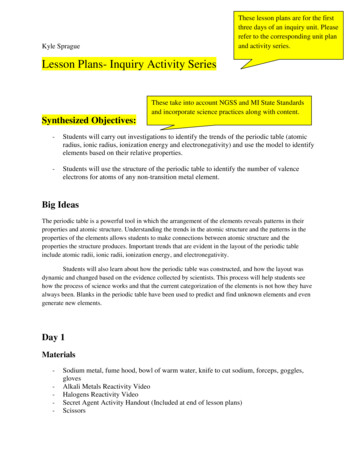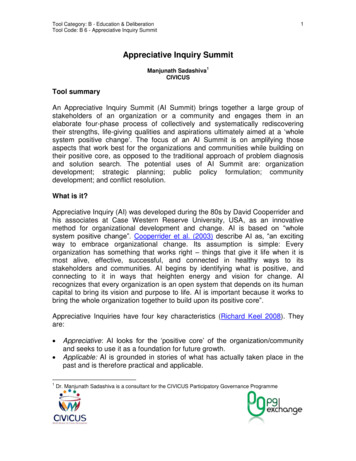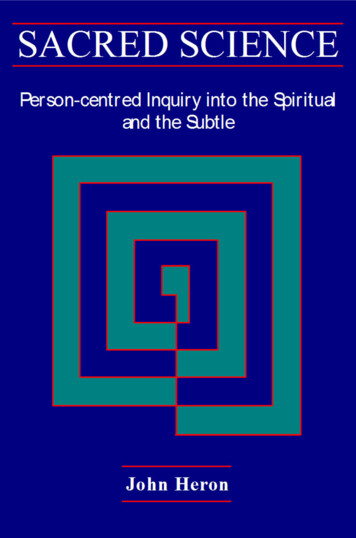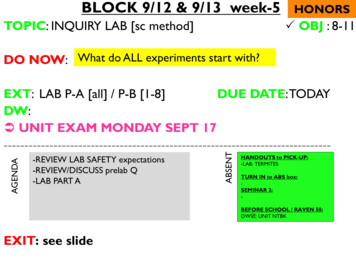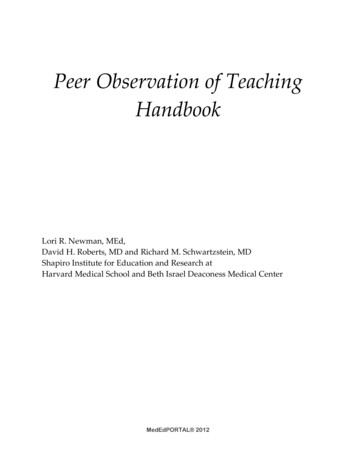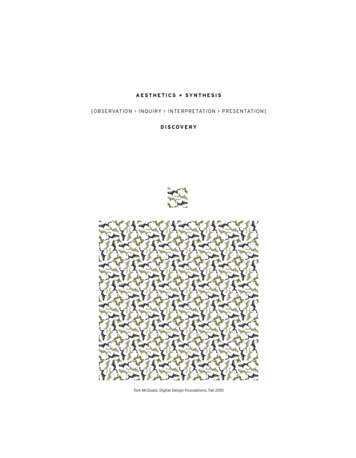
Transcription
A E ST H E T I C S SY N T H E S I S[ O B S E RVAT I O N I N QUIRY INTERPRETATION PRESENTATION ]D I S COV E RYTom McQuaid, Digital Design Foundations, Fall 2010
Digital Design Foundations FNAR 264/636-910 Summer 2011Professor: David CombergSeeing comes before words. The relation between what we see and what we know is never settled.John Beger, Ways of SeeingIf you work intensely and slowly, things will happen that you would never imagine.Aaron SiskindExercises:This course is about learning to see. It is an introduction to the ideas and language artists and designersuse to structure their work and to the digital tools they use. The course explores various ways100 Arrowsto structure 2-dimensional space using abstract and representational forms and introduces30 seccond portraitsconcepts of sequence and visual narrative. The course seeks a balance between free explorationVideos:and discovery within parameters.Tim Brown: The PowerfulLink Between Creativity andPlayThe course focuses on design both as a mental discipline and as a set of skills; as both a process and aset of techniques. It positions design as a state-of-mind and a form of inquiry, and focuses on:Powers of 10 creative exploration and speculation aesthetics and synthesis techniques not for their own sake but as a means to facilitate expression/communication principles of organizing space and communicating with images the process of arriving at a solution rather than the solution itself preparing the student for further study.This course should prepare students to: think clearly and creatively about visual design analyze visual problems thoroughly and from multiple perspectives develop multiple project proposals — quantity is important, too! speak critically about art and design, both your own design and the work of others take creative risks, maintain curiosity, and discover new techniques and technologies create with a variety of digital and manual toolsThe class will serve as a laboratory for rigorous, directed investigation and creative problemsolving. Students will explore through making and will use manual and digital tools to createpreliminary plans and drawings, and refine work for presentation in a variety of media. Studentsshould keep an up-to-date sketchbook and journal of progress and will produce a number of shortexercises and larger projects. A brief mid-term meeting will be held with each student to reviewprogress. A portfolio, showing both finished works and the process through which that work wasdeveloped, will be due at the last class.Course work will follow a general model of observation, inquiry, interpretation, and presentation.Class time will be used for project work, short presentations, discussion, and critiques. Plan onspending approximately 6–8 hours per week working on projects in addition to class time.
Digital Design Foundations FNAR 264/636-910 Summer 2011Course requirements: attend all classes on time and prepared to work complete all assignments fully and on time participate in critiques, explaining and justifying work and offering criticism of other students’ work keep a record of readings, sketches, etc. submit completed projects to Course Folder on FNAR server on date due complete readings and participate in discussion and class blog turn in a portfolio of course work on the last day of classAdobe CS4Mac Pro Quad 2.66 GHz Intelrunning Mac OS 10.5xHP DesignJet 550042” Large Format PlotterGrading:50% of your grade is based on attendance and participation in class and tutorials; 50% is based on work produced. Threeabsences results in one letter grade drop in final grade. The projects are weighted equally and will be evaluated based onyour design process and how effectively designs are completed. The SAS grading system is as follows: A / A 4.0, A- 3.7,B 3.3, B 3.0, B- 2.7, C 2.3, C 2.0, C- 1.7, D 1.3, D 1.0, F 0.0. See the SAS web site for more information. I willschedule a short meeting with each student at mid-semester to discuss work to date, progress, and grade. Please see me ifPhaser 7750GXColor Laser Printeryou have any questions about grading.HP 8150 LaserJet B/W printerSystems Info:2 Epson Stylus Pro 1400 ColorInk Jet PrintersRemote Access to ServerStudent allocation: 2GB on thePenn Design ServerPenn Design systems info: www.design.upenn.edu/comp/index.htmlPenn Design Remote Access: www.design.upenn.edu/remoteaccessTo view your printing charges see PennDesign Resources Printing & PlottingStudent Property:Work produced in courses at the School of Design is the property of the student. By participating in a course each studentgrants the School of Design a non-exclusive right and license to use, copy, distribute, display and perform such work inMisc. Web Resources:any and all media for educational, programmatic and/or promotional purposes. The School of Design will exercise carelynda.comdelicious.com/comberg/DDFwith respect to student-created materials submitted in conjunction with a course; however, the School of Design does notEach project has a relatedreading. Designated discussiongroup leaders will beresponsible for summarizingthemes in reading and leadingdiscussion (approx 20 mins).Readings are in Course Folder.assume liability for their loss or damage.PennDesign 2008–2009 Student HandbookReadings/resources:Handouts and readings in Course Folder and at delicious.com/comberg/DDFReading for May 25: Annette Tietenberg, The Pattern Which ConnectsReference Books:Design Basics, David Lauer, Wadsworth, 1999Principles of Two-Dimensional Design, Wucius Wong, Van Nostrand, 1972Discussion leaders:Abstracting Craft: The Practiced Digital Hand, Malcolm McCullough, MIT Press, 1998Basic Design: The Dynamics of Visual Form, Maurice de Sausmarez, Design Press, 1980Ways of Seeing, John Berger, BBC/Penguin, 19721 Shapes, Spaces, PatternsAbstraction in Art and Nature, Nathan Cabot Hale, Dover, 1993Office Hours: by appointment, before/after class2 Graphic TranslationDavid Comberg: comberg@design.upenn.eduNOTE: Lab fees not refunded after week week 23 Space, Perspective, Atmos.4 Fictional Portraits5 Visual Narrative
Digital Design Foundations FNAR 264/636-910 Summer 2011Design:a preliminary sketch indicating the plan for something; the act of working out the form of something;an arrangement scheme; something intended as a guide for making something else; a decorative orartistic work; a preliminary sketch indicating the plan for somethingAbstraction:a genre of art where artistic content depends on internal form rather than pictorial representation;painting or sculpture, which simplifies, distills, or distorts figures from the real world. Abstract artemphasizes forms, lines, and colors. Abstract elements include line, shape, pattern, space, lightness/darkness, and color (Abstraction in Art and Nature, Hale)Synthesis:Class Blog:ddfblog.wordpress.coma process of combining things into a unified (new) wholeResources:A German word for “form,” defined as an organized whole in experience. The Gestalt psychologists,delicious.com/comberg/DDFabout 1912, advanced the theory, which explains psychological phenomena by their relationships to totalGestalt:forms rather than their parts. A perceptual pattern or structure possessing qualities as a whole thatcannot be described merely as a sum of its parts, like the figure/ground relationshipAesthetics:the branch of philosophy dealing with such notions as the beautiful, the ugly, the sublime, the comic,etc., as applicable to the fine arts, with a view to establishing the meaning and validity of criticaljudgments concerning works of art, and the principles underlying or justifying such judgments.Critique:To judge critically; a serious examination (of a work) in order to supply useful criticism to the creatorSupplies:Dick Blick1330 Chestnut St(215) 525-3214www.dickblick.comUrecht2020 Chestnut St(215) 563-5600www.utrechtart.comsketch/notebook — wire-o bound, 8x10” or biggerpencils, pens, markersglue stick or other quick adhesive18 inch metal rulermatte knife or X-acto knife and #10 blades1 pair of good quality scissorsbone folder (for book binding)flash drive, CDs or other portable digital storagedigital camera and cable (not required — cameras available from Fine Arts Photo dept.)Please have materials available for every class.Lockers in the hallway are available for storage—get a lock
Digital Design Foundations FNAR 264/636-910 Summer 2011Project 1: Sound, Shape, Space, PatternMay 23—May 31; Pin-up: Tues, May 31In this first exercise you will work with abstract, non-objective shapes in a fixed space and develop theshapes and space of the composition through use of a variety of organizing principles. You’ll use all thenetworked printers in the MacLab.Temporary log-in:Username: addamsPassword: Temp1234Listen to each of the 3 music/sound clips presented in class and write a series of WORDS ORPHRASES in your sketchbook that describe its sound. Think about tempo, pitch, rhythm, melody,mood, etc. Listen to the clips again and hand draw BLACK SHAPES that represent your visualinterpretation of the sound of each clip. From your list of words and sketches of shapes, chooseone word and one shape from a single music clip to complete the 3 parts of this project. Refine thisshape by hand drawing, then once you are satisfied, recreate the shape in Illustrator using the pentool.In Illustrator, open a new document and set up the following portrait Letter (8.5” x 11”) page:Open Illustrator Prefs and set grid lines every .25” with subdivision of 1Use the Rectangle Tool and draw a 6” squareUnder View menu, turn on Snap to GridPosition the square 1.25” from the top of page and 1.25” from the left edgeOutline the path of the square with a .5 pt black strokeView grids so that you see a grid of .25” squaresUnder Object menu, Lock Selection and in Layer dialog boxMake a new layer, Save to the Local Data drive1.1 Shapes in Space (8.5x11” page, 6” square): use your shape to create a composition thatreflects the character of the music and word you chose. Use the shape up to three times, but don’tscale or overlap the shapes. Consider how negative and positive spaces relate and interact. Thinkabout how emphasis, scale, cropping, figure/ground relationships, and balance can be used toachieve your intended composition.1.2 Pattern Generation (11x17” page, 8” square): using your composition from above, select andcrop a 1” square unit that you will repeat to create a pattern that fills the 8x8” space. Look carefullyat your shape to determine how it fits next to itself and then consider what type of pattern networkshould be used to visually represent your chosen word. Your pattern can be a unit within a unit orany other form generated from your original shape. A repeat of the pattern must be obvious. Usethe edges of the 8”x8” space deliberately. Don’t overlap. Design three patterns:In the first, repeat unit without altering (A A A)In the second, repeat and rotate in a regular rhythm (turning or reflecting 90º, -90º or 180º) (A A)AFine Arts computer accountswill be assigned to registeredstudents.In the third repeat, rotate, and reflect in any rhythm or pattern within the grid.1.3 Composition (sheet size 42x42”; image size 36x36”): create a new composition that draws onthe pattern but also creates additional spatial relationships. Use scale, neg/pos shapes, figure/groundrelationships and transparency to suggest depth in the composition. Enlarge final composition to36x36” and print to plotter in black and 1 additional color.Resources: http://www.alanthegallant.com/i pattern.htmlVideo: Tim Brown on Creativity and Play (see delicious site)
Digital Design Foundations FNAR 264/636-910 Summer 2011Project 2: Graphic TranslationMay 31—Jun 7Observation Pencil sketches Form analysis Shape translation Graphic representationA graphic translation is a reductive, interpretive, visual representation, that, when renderedwith efficiency and elegance, can communicate the essential characteristics of the original subject.Studies:On a Tabloid page, makea grid of 25 form studies.Choose one and enlarge.In this project you’ll analyze natural forms and translate into simplified graphic forms. In the secondpart of the project, after producing a number of studies, you’ll compose a visual interpretation thattransforms and expresses the subject’s inherent characteristics (anthropomorphic, zoomorphic, orother interpretations).To start find a plant leaf, a flower, or other symmetrical natural form. Sketch from observationto understand the forms. Break the shape down to its primary forms. View from multiple angles,make lots of sketches—10 pages in your sketchbook—analyze the forms, and develop a strategy fortranslating to a black and white graphic image. A profile or silhouette is a quick way to express theoutline of the form. Reduce complex forms to simplified or ‘essential’ shapes. Consider how manydifferent shapes you’ll need and how they connect and interrelate.Scan the final drawings and use them as a reference to trace from in Illustrator. Use the pen toolto create the shapes—use no lines, use EXPAND to convert everything to shapes. Edges, highlights,shadows, reflections and other details must be made with black and white shapes. Use black only.Generalize, simplify, exaggerate, and translate the form.Create a set of studies and a final composition:Design a grid of studies and select one graphic as a final representation. Produce a composition fromyour studies using black and two colors.Print the first set B W on tabloid size paper. Print the second on the color laser and final on theplottter for critique Tues, June 7
Digital Design Foundations FNAR 264/636-910 Summer 2011Project 3: Space, Perspective, AtmosphereJun 7—Jun 14(At the door of the house, who will come knocking?An open door, we enterA closed door, a denThe world pulse beats beyond my door)Gaston Bachelard, The Poetics of SpaceHow do you see and experience spaces? In this project you must sketch a place (from memory,photograph, or direct observation) that evokes meaning or emotion for you. To start, draw a spacefrom observation, in 2pt-perspective. Draw what you see—volumes, shapes, architectual details,spaces between things, fences, steps, walkways, corners, doors, windows, and furniture. Fill 10 pagesof your sketchbook with these sketches of the spaces—don’t make beautiful drawings, use drawingas your way to remember and understand the space. Sketch some for 10-15 minutes, others for 3–5minutes. Use different tools to explore how they affect your sketch.Using the sketches as a guide, design a series of images in Illustrator that capture the qualities of thespace in two-point perspective. Construct a two-point perspective grid and use it to accurately renderthe spaces. You can use additional objects and photographs as references to reconstruct the spaces.Focus on details : the edge of a door, a window ledge, the leg of a table, the arm of a chair — then create acomposition that expresses the feelings about that space: warm and comforting, large and alien, dark andmysterious, etc.Construct a composition that places the viewer inside the picture, scaling, overlapping and building thecomposition from the shapes, shadows, and objects in the space. Express an emotional or psychologicalcondition by the way you compose and color the picture. Consider how shapes interact with the edgesStart your design bysketching simple rectangularobjects—books, packages,etc.—from observation.of the picture plane and with other shapes, how figure and ground interact, and how each part ofTranslate your sketches toconform to the principlesof 2pt perspective, and addlight, shadow, reflection, andtexture.Analyze each object’s forms and volumes: how they fill space; how they project toward you and recedethe composition relates to the whole. What is the weight of the furniture? How is light absorbed orreflected? To create a sense of spatial depth, overlap shapes, alter scale, and change transparency.away from you; how light falls on and through them; how they cast shadows; how one volume interactswith adjacent volumes.Begin the project in Illustrator but move freely between Illustrator and Photoshop. Print studies on thelaser printer and select one composition to enlarge and print on the plotter.Percy BrightEliot Kaplan
Digital Design Foundations FNAR 264/636-910 Summer 2011Project 5: Fictional PortraitsJun 23–Jul 1, Critique: Thurs, Jul 1Both morally and aesthetically. the belief in truth was one of the most essential elements of the(modern) artistic enterprise. Now, with the direction of science toward the creation of artificial lifeforms and computerized virtual reality, and with the emphasis on image, rather than substance, incommunications and in the marketing of everything from automobiles to politicians, the traditionalsearch for truth has perhaps become obsolete. —Jeffrey Deitch, Artificial NatureSubversive ambiguity is the central strategy of photomontage. —Dawn Ades, PhotomontagePhotomontage: the technique of making a picture by assembling pieces of photography; often incombination with other types of graphic material. —photomontage.comSilhouette the head.Concentrate your work onthe portrait: the face, head,neck, and shoulders.To silhuette portrait see themasking movie on the CourseFolder:04 maskinghair.movDesign a portrait of a fictional personality, using a photo of yourself or a classmate.1. Photograph high-resolution portraits of yourself, classmates, or other accessible people—head andshoulders—and silhouette in Photoshop. Pose, use props, accessories, etc.2. Develop a concept and strategy for your character and write a brief contextual statement:This hybrid of bird and cyborg human is well-suited for the future earth atmosphere because it 3. Assemble and combine with other images (use only camera or scanner) to create a photo composite.No web image downloads.4. Use Photoshop to assemble, retouch, augment, add, subtract, and alter the original to create the newfictional personality.Develop three studies and print one final portrait on plotter for critique on Thurs, June 30.Resources:Penn Library Online Image age/all/Photomontage, Dawn Ades. Thames and Hudson, and-resources.htmlArtificial Nature; Post Human; Jeffrey Deitch, exhibition catalogshttp://www.customcreaturetaxidermy.comBeth Cavener Stichter, Cindy Sherman
Digital Design Foundations FNAR 264/636-910 Summer 2011Project 5: Visual Narrative: Storytelling With ImagesJune 21–June 30Prototype: June 28; Final critique: June 30(Narrative) is derived from the Latin narrare–’to relate,’ [and] rooted in the Greek gno, to know.narrative relates all of its parts to each other. Michael Roemer, Telling Stories, 1995(Narrative) is the form of the story [not the content of the story].Gerard Genette, Narrative Discourse, 1980Our lives are ceaselessly intertwined with narrative, with the stories that we tell and hear told, thosewe dream or imagine or would like to tell, all of which are reworked in that story of our own livesthat we narrate to ourselves in an episodic, sometimes semiconscious, but virtually uninterruptedmonologue. We live immersed in narrative, recounting and reassessing the meaning of our pastactions, anticipating the outcome of our future projects, situating ourselves at the intersection ofseveral stories not yet completed. The narrative impulse is as old as our oldest literature: myth andfolktale appear to be stories we recount in order to explain and understand where no other formof explanation will work. The desire and the competence to tell stories also reaches back to anearly stage in the individual’s development, to about the age of three, when a child begins to showthe ability to put together a narrative in
To view your printing charges see PennDesign Resources Printing & Plotting Student Property: Work produced in course
